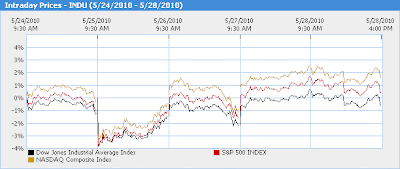Another volatile week on Wall Street saw the major indices close relatively unchanged. For the week, the Dow lost 0.6%, the S&P rose 0.2%, and the Nasdaq was higher by 1.3%. Friday also marked the end of the month, which turned out to be the worst May performance since 1962. The Dow closed lower by 8.2%, the S&P dropped 8.6%, and the Nasdaq fell by 8.7%. Oil dropped by 14% in May, one of the few bright spots in an otherwise awful month.
Source: MSN Moneycentral
With the poor performance of the prior week, it was encouraging to see markets hold their levels and not continue further downward. While it is too early to tell if we have seen a bottom, the stabilization of this week was certainly a positive indicator. This high level of volatility means the market can turn on a dime, so we remain cautious. However, if volatility moderates and the markets can hold these levels, we will resume buying as bargains can be found. For the time being, we are content sitting safely on the sidelines.
In a continuation from last week, global macroeconomic issues were the driving factor of the market. Concerns over the European debt problems still linger, as
Here in the
Next Week
With a holiday-shortened week, we will be closely watching the market to see if it can continue to hold these levels. Any surprises out of
Where are we investing now?
Despite the recent market losses, last week gave us more confidence in a market rebound. We remain on the sideline at this time, but will be reentering the market if conditions are right. Our outlook still remains the same, as we are still optimistic through the end of the year since the easy money and stimulative measures will help push the markets higher. Additionally, the lower oil prices this month (although higher this week) equals lower gas prices at the pump, an obvious benefit for consumers. Higher interest rates, higher taxes, increasing government involvement in the private sector, and a still-high unemployment rate have us worried for the longer term.
In equities, we are focusing on higher-quality and multi-national stocks, but some smaller stocks look promising, as well. We continue to avoid banking and insurance sector stocks, and new government regulations have us staying out of oil companies. TIPs are important as we expect inflation to increase in the future, while

